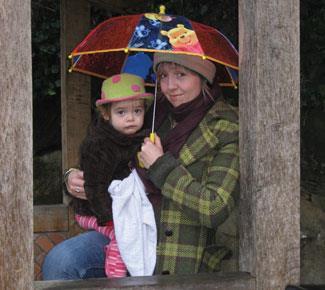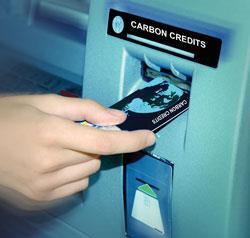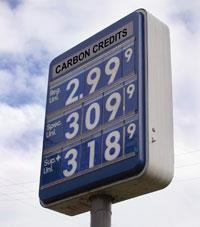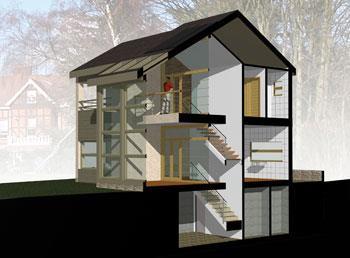One way to tackle global warming is to give people a 'carbon ration' that limits their emission of greenhouse gases. Helen Pilcher reports
One way to tackle global warming is to give people a ’carbon ration’ that limits their emission of greenhouse gases. Helen Pilcher reports
I’m sitting on a bus singing ’If you’re happy and you know it’ with my rambunctious two-year-old daughter, and feeling pretty pleased with myself. Not just because I’m annoying the other passengers, but because the number 536 Routefinder is helping me slash my carbon dioxide (CO2) emissions and save the planet from catastrophic climate change. What a lovely bus.

I’m trying an experiment. The UK government has promised that, by 2050, Britain will cut its CO2 emissions by 60 per cent, and according to the UK government’s Department for environment, farming and rural affairs (Defra), about 40 per cent of the country’s carbon emissions come from households - in other words, you and me.
So I’m trying to decrease my emissions by living on a low carbon budget for a week. That means fewer car journeys, turning down the thermostat and wearing a thermal vest at all times.
’Awareness of climate change is now higher than ever and there is a real acceptance among people of the need to take action,’ says the government’s environment secretary David Miliband.
’We all need to take action to change our lifestyles. We need to think about the way we use energy in our homes and when we travel.’
Carbon rationing isn’t just a personal fancy. A growing band of politicians (including Miliband) and scientists are touting it as the fairest and most practical way to cut emissions of greenhouse gases such as CO2 and methane.
Give them credit
The idea is straightforward. Each year, every adult in the UK would be given a number of carbon credits. Any time we boil the kettle, flick a light switch, heat our homes or drive, CO2 is released into the atmosphere. So every time we buy energy or fuel, carbon credits would be deducted from our personal allowance. If you run out of credits but still want to make the tea, you either need to start collecting firewood or buy some more credits (see box, p43).

The idea of treating carbon as currency may seem a little unusual but a similar scheme already exists for industry. Over 12,000 organisations across the European Union subscribe to its Emissions Trading Scheme (ETS), buying and selling the right to emit CO2. Having a fixed number of credits in circulation caps the total possible carbon emissions in each year. It also provides two financial incentives to cut emissions: it punishes those who engage in profligate fossil fuel burning, while encouraging economising by allowing those who finish the year with an excess of credits to sell them back into the system.
In practice, the government would set an annual carbon budget that decreased a little each year until the 2050 target was reached. But I don’t want to wait 43 years. So I call the man who knows all about carbon budgets, Richard Starkey from the Tyndall Centre for climate change research in Manchester. Starkey was co-author (with Kevin Anderson) of Domestic tradable quotas: a policy instrument for reducing greenhouse gas emissions from energy use, a report published in December 2005 that outlined exactly how a personal carbon credit scheme might work. David Miliband was sufficiently impressed to propose, in July 2006, a scheme based on the report’s recommendations. Responses on Miliband’s blog have, incidentally, rated the scheme as anything from ’excellent’ to ’Orwellian’, and the idea is still under consultation.
Starkey suggests that I could simulate living on a carbon budget in 2050 by first working out how much CO2 my household chucks out per week, and then trying to reduce it by 60 per cent the following week. Despite the fact that we’re a two car family, I’m quietly confident.
The challenge
The first job is to jot down our cars’ mileages and the house’s utility meter readings. I repeat the process a week later, calculate the difference and plug the figures into a helpful CO2 calculator on the internet (see Further reading). One click of the mouse and I find out that my household has spluttered out 275 kilograms of CO2 in a mere seven days. That means we’re spot on the national average, destined to emit around 12 tonnes of CO2 over the next year - enough gas to fill more than two standard hot air balloons.

No wonder there is a 75 per cent chance that global temperatures will rise by 2 or 3?C over the next 50 years, according to the government-commissioned Stern report, published in October 2006 (see Chemistry World, December 2006, p8). And as anyone who has ever cooked a souffl? will tell you, even a tiny temperature change can have devastating effects: melting glaciers, rising sea levels, more extreme weather, and an increasing number of species facing extinction are all on the cards.
So how am I going to slash my household CO2emissions by 60 per cent next week? The first step is to use my car as little as possible, since it clocked up 150 miles and 47 kilograms of CO2 last week. So we start our energy-saving week with a single, judiciously-planned car trip. In one journey we nail the weekly shop, a visit to the DIY centre to buy energy saving light bulbs, and a jaunt to the bottle bank to recycle the dozen empty Pinot Grigio bottles that have mysteriously appeared since I started researching this piece. It’s a 15 mile round trip, spewing out 5 kilograms of CO2.

For all future journeys, we use public transport. I tell my daughter Amy that we’re catching the bus to save the polar bears. She mistakenly thinks we’re going to the zoo and looks profoundly dejected when I correct her.
But my husband feels less benevolent: the alternative to his 20 minute daily commute is a two-bus, one-train, two hour journey from hell, so he sticks to his car. We’ll just have to make cuts elsewhere.
I contact the Energy Savings Trust, a non-profit organisation funded by government and industry which offers advice on energy efficiency, and ask them what to do. They suggest a glut of immediate changes, including turning the thermostat down a degree or two, switching appliances off standby, fitting our new energy efficient lightbulbs, and turning off lights and radiators in rooms we’re not using. If we had longer than a week for the experiment, I might also upgrade my boiler and loft insulation, but, like most people, I’m lazy and loath to fork out big bucks.
But despite taking their advice, when I check the meters half way through the week we’re a long way off our target. So I surf the web for more carbon cutting tips and come across a site that recommends green electricity tariffs. Many electricity suppliers now offer a ’green’ option, but in many cases, it seems that a token contribution to wind power schemes is about as far as their green credentials stretch. Just four per cent of the UK’s electricity is generated from renewable sources, such as water, wind and biomass. The rest comes from a mix of non-renewable or CO2-producing sources, such as coal, gas, oil, and nuclear. Grid energy is a mix of the two, so most UK homes receive ’good’ and ’bad’ electricity, regardless of tariff. The best chance to cut as much carbon as possible out of our electricity supply is to find an energy provider that ploughs all their profits back into building new renewable energy sources.
Even if we switched now, it’d be too late to affect this week’s experiment. But just by taking the bus and conserving electricity and gas, we managed a 25 per cent reduction in CO2 emissions, meaning we’ve saved 67 kg of CO2. If we keep it up, that’ll make a cut of over three tonnes in the course of a year.
’I’m impressed,’ says Starkey. ’It shows what people can do when they put their mind to it.’ It’s less than halfway to my target, but it makes me think that I might be able to live on a real carbon budget. Not bad for the first (albeit non-official) pilot study of a personal carbon allowance scheme.
Carbon choices
But Starkey’s scheme is not without critics. Opponents think carbon rationing too complicated for users to cope with and too tricky for governments to administer. If many people simply ignored the scheme, they argue, the price of carbon units would rocket, hardship stories would hit the headlines, and the scheme would be abandoned under a cloud of political fallout.
Another argument (and Amy’s daily mantra) is that it’s just ’not fair’. Only the rich would be able to afford extra credits. Rural dwellers and the elderly would be hit especially hard. And the scheme infringes civil liberties because our personal credits would be monitored by a central database.
’People have strong reactions to the idea. They either think it’s great or ridiculous,’ says Starkey. He believes most people will grasp and comply with the scheme because it’s simple and it places responsibility for climate change with the whole population. ’It’s about as fair as you can get,’ he says.
Starkey’s vision of a carbon credits scheme, which automatically gives every person a free carbon allowance, is not the only option. The US Congressional Budget Office assessed the impact of personal carbon credit schemes in a June 2000 report, and concluded that the fairest way of allotting the carbon allowance would be for the government to auction them all off to the highest bidder, rather than simply giving them away. This provided more revenue to plough back into the system, offering rebates to poorer households most likely to suffer - and shiver - under the scheme. But Starkey points out that giving people cash rebates, rather than more credits, removes their choice of when to sell their units, and who to sell them to. Another version, called the RAPS scheme - for ’rate all products and services’ - seeks to carbon rate everything, not just fuel and power. All products - from tin-openers to tomatoes - have a carbon cost linked to their manufacture and transport, as do services such as hotel stays or hair cuts. The RAPS scheme might become more achievable as more products and services become carbon rated. Boots, for example, is producing a low-carbon shampoo and an increasing number of airlines are spelling out the CO2 emissions linked with flights.
Carbon rationing: how it works

Although it’s not the only way to ration carbon, the Tyndall Centre’s approach is perhaps the most common model. The country’s entire carbon budget - essentially the total amount of carbon dioxide expected to stem from the nation’s activities - would be split into carbon credits, with 1 unit likely equivalent to around 1 kilogram of emitted CO2. Households currently emit around 40 per cent of the UK’s CO2 emissions, so 40 per cent of the credits are allocated equally and without charge to every adult in the country. The remainder are auctioned to organisations who then sell them on to businesses that need them.
Imagine you stop to fill up the car with petrol. When you hand over your cash, you also hand over your carbon debit card and the sullen teenage cashier deducts the relevant number of credits. The same goes when you buy electricity, gas and other types of energy. Extra credits can be bought and excess sold.
Like other tradable commodities, the price goes up and down, but householders hoping to get rich quick from the CO2 handouts will be disappointed: the first year’s allowance would only be worth an estimated ?27 per person.
Carbon weaning
Of course my experiment can only give a snapshot of the bigger picture. If carbon rationing were to be introduced, people would have time and an increasing number of green technologies to help them adjust to gradual CO2 reductions. And it’s not just about installing wind turbines and solar panels, although they’ll undoubtedly help. Carbon rationing would have to be supported by creating a low carbon infrastructure, where renewable energy sources are in place to help reach that fabled 60 per cent reduction.
Onshore wind farms, which currently supply around 1 per cent of the UK’s electricity, are the UK’s most advanced source of renewable energy. And by 2020, they could be supplying around one fifth of the UK’s electricity needs, according to Mark Williamson, head of technology acceleration at the Carbon Trust, which helps businesses to reduce carbon emissions. In December 2006, the UK government gave an initial go-ahead for the world’s largest wind farm to be built off the Kent coast. The London Array is expected to generate 1000MW and would displace nearly 2 million tonnes of CO2 a year. Add in other sustainable technologies, such as wave, tidal and offshore wind, and the figure could rise even further. Replacing gas and oil for heating may prove a tougher nut to crack. One option is to fit houses with ground source heat pumps (see box). Another is solar thermal systems, which can provide a good proportion of a household’s hot water needs, despite Britain’s erratic weather. And a third, burning biomass such as wood, is already a hit in Scandinavia and Austria where it provides around a fifth of total primary energy. And all 16 major UK coal-fired power stations are adding a small percentage of biomass to their coal, a process called co-firing that is a move in the same direction.
Although CO2 gets released when the biomass is burned, it’s roughly the same amount that is absorbed by the plant during its lifetime. This ’carbon neutrality’ is all very well, but it doesn’t actually reduce the overall amount of carbon dioxide in the atmosphere. However, US researchers have recently found that certain grasses could actually be a carbon negative fuel, because they help to lock extra carbon into their roots. Even if the plant’s stalks are burnt, their roots are resistant to breakdown by bacteria and can lock carbon into the soil for centuries. These are all attractive options, ’but there’s no single low-carbon solution to provide for all our energy needs,’ says Williamson. ’We’ll need a portfolio of different technologies.’
Conscience cleansing
Another way to cut more of the carbon from our lives is by offsetting it. An increasing number of companies offer services that will calculate how many tonnes of CO2 we emit, and then absorb that CO2 somewhere else, usually by planting trees - all for a fee, of course. But do these schemes actually work, or are they just allowing you to buy a cleaner conscience?
’Offsetting makes people think about the CO2-related cost of their actions, which is a good thing, but it’s no substitution for emission cuts,’ says Michael Buick, marketing and communications manager for carbon-offsetting company Climate Care.

And recent studies have shown that while planting trees may suck up carbon dioxide, they can also help to warm the planet in higher latitudes. The grasslands and snowfields of boreal regions normally reflect sunlight, helping keep temperatures low. But plant dark-leaved forests in the same location and they’ll absorb more heat, counteracting the cooling effect of photosynthesis removing carbon from the atmosphere.
’It’s not clear that planting forests outside the tropics is going to make any difference to climate change,’ says Ken Caldeira from the Carnegie Institution of Washington in Stanford, California, US, part of the research team who presented their findings on 15 December 2006 at the American Geophysical Union meeting in San Francisco. His team found that above 50 degrees latitude, forests warm the Earth by around 0.8?C, but in the tropics, forests help to cool the planet by a similar amount. Planting trees in mid-latitudes has no net effect on climate change. So why bother planting non-tropical forests at all?
’There’s no denying the fact that if you plant trees on land with a low carbon density, carbon levels in the vegetation will go up,’ says Forestry Commission researcher Robert Matthews, who studies links between forestry and climate change. But you need the right trees in the right place. Long-lived slow-growers such as oak, beech and Scots pine are favourites in the UK because (if managed correctly) the forests can lock away carbon for thousands of years. And when the land becomes carbon saturated, the trees can be cut down and used to replace fossil fuels.
Around a tenth of the UK is covered by forest that contain around 150 million tonnes of carbon, roughly equal to just a year’s worth of our CO2emissions from burning fossil fuels and industry. To become carbon neutral, the Forestry Commission calculates we’d need to plant an additional 50 million hectares - approximately twice the land area of the UK.
So we clearly need to emit less CO2 in the first place. Which brings us back to personal carbon budgets. Will they ever become reality? ’I just don’t know,’ says Starkey. The Kyoto protocol, an intergovernmental agreement setting targets for reductions in greenhouse gas emissions, still sets the benchmark for carbon trading schemes. But Kyoto expires in 2012: ’Who knows what’ll happen after that,’ says Starkey.
Low carbon dream homes
A new energy efficient home, being built on the campus of the University of Nottingham, UK, has been designed to emit 60 per cent less CO2 than typical houses.
Instead of brick and mortar, its walls are made of insulation propped up by a lightweight steel frame. Special render, called SmartBoard, will retain the heat from the sun during the day and release it into the house when temperatures drop. A layer 1.5 centimetres thick has the same thermal storage capacity as 12 centimetres of brick.
Instead of a boiler, the house features an inbuilt ground source heat pump, where holes bored deep into the ground shuttle energy from the warm earth into the house. A natty conservatory acts as an energy cell, providing free solar heating in winter, with roof mounted wind turbines and solar panels generating extra heat.

Add in triple glazed windows, water recycling, the latest in energy efficient light bulbs and smart lighting that turns on and off as you move around, and you’ve got a state of the art, low CO2-emitting dream home. The new house, which should be completed in March 2007, will be inhabited by university staff and students who will monitor every aspect of day-to-day life, such as heating, lighting, energy and water consumption, over the next 20 years.
’We can build these houses now,’ says Mark Gillott, lecturer in sustainable energy technology at Nottingham University. ’They’re energy and cost efficient. We just need to persuade industry that it’s the way to go.’






No comments yet